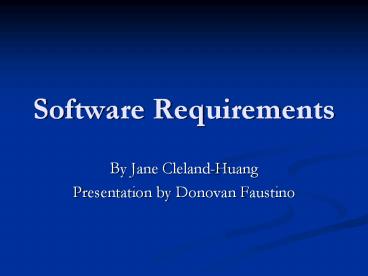Software Requirements - PowerPoint PPT Presentation
Title:
Software Requirements
Description:
Software Requirements By Jane Cleland-Huang Presentation by Donovan Faustino Introduction Requirements Engineering - process of eliciting, analyzing, validating, and ... – PowerPoint PPT presentation
Number of Views:730
Avg rating:3.0/5.0
Title: Software Requirements
1
Software Requirements
- By Jane Cleland-Huang
- Presentation by Donovan Faustino
2
Introduction
- Requirements Engineering - process of eliciting,
analyzing, validating, and managing requirements - IEEE standards such as IEEE Std 830-1998 provide
guidelines for recommended practices
3
Requirements
- Defining Requirements
- property of the system or a constraint placed
either upon the product itself or upon the
process by which the system is created. Formally
IEE Std 610.12.1990 1) A condition or
capability needed by a user to solve a problem or
achieve an objective - 2) A condition or capability that must be met or
possessed by a system or system component to
satisfy a contract, standard, specification, or
other formally imposed documents. - 3) A documented representation of a condition or
capability as in (1) or (2).
4
Phases of Requirements
- Elicitation
- Analysis
- Specification
- Management
- Validation
5
Elicitation
- proactively working with stakeholders to discover
their needs, identify and negotiate potential
conflicts, and establish a clear scope and
boundaries for the project
6
Elicitation(cont)
- Understanding the Problem and Its Domain
- Making the business case
- current trends have organizations are no longer
willing to invest in IT projects unless those
projects return clear value to the business - From a requirements perspective, these include a
lack of clear purpose for the product,
insufficient stakeholder involvement, lack of
agreement between stakeholders, rapidly changing
the requirements, goldplating(adding additional
and unnecessary features), poor change
management, and lack of analysis of the
requirements
7
Elicitation(cont)
- Elicitation techniques
- Collaborative sessions
- Interviewing techniques
- Questionaires
- Ethnography
- Protyping
- Documentation
- Modeling
- Roleplaying
- Checklists of NFRs
8
Elicitation
- Conflict Identification and Negotiation
9
Analysis
- a deeper understanding of the product and its
interactions, identify requirements, define
high-level architectural design, allocating req
to architectural components, and identify
additional conflicts that merge through
considering architectural implementations and
negotiating agreements between stakeholders
10
Analysis(cont)
- Conceptual Modeling
- ML is very well known.
- IEEE Std 1320.1, IDEF0 for functional modeling
and IEEE Std 1320.2 IDEF1 X97 for information
modeling. - Architectural Design and Requirement Allocation
- Architectural quality is measured by its ability
to fulfill the stated requirements
11
Specification
- documents that capture the system and software
req. in order to support their systematic review,
evaluation, and approval. Document that describes
the system to be developed in a format that can
be reviewed, evaluated and approved in a
systematic way.
12
Specification(cont)
- Qualities of an Individual Requirement
- Concise
- Correct
- Nonambiguous
- Feasible
- Verifiable
13
Specification (cont)
- Qualities of the Set of Requirements
- Realistic
- Concise
- Complete
- Consistent
14
Validation
- goes through the other four activities. Ensure
the system meets stakeholders requirements
through activities such as formal and informal
reviews
15
Validation(cont)
- Types of validation
- Reviews
- Prototyping
- Model validation
- Acceptance Tests
16
Management
- starts from the moment the first req is elicited
and ends only when the system is finally
decommissioned. requirement management includes
software configuration management, traceability,
impact analysis, and version control
17
Management(cont)
- Requirements traceability
- Ability to describe and follow the life of a
requirement, in both a forward and backward
direction. - Change Requests
- Managed systematically
- Requirements attributes
18
Conclusion
- Traditional Method
- Agile Methods
19
My own opinion
20
Validation































